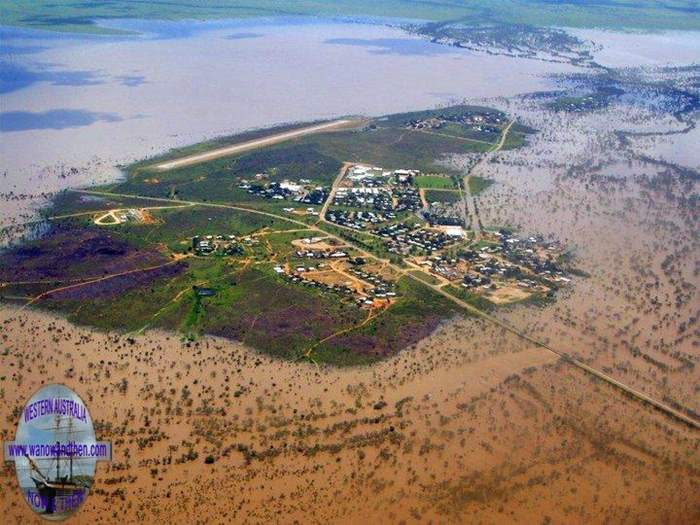DESCRIPTION
Like its nearest neighbour, Halls Creek, there isn't much about the town of Fitzroy Crossing that will impress tourists, but only 20km to the north is the
magnificent Geikie Gorge - Danggu. Further north again is Windjana Gorge and an access point to the Gibb River Road.
Geikie Gorge was named after a British botanist, Sir Archibald Geikie
in 1883 by Edward Hardman. The gorge has now been named Danggu which is the Aboriginal name for the area.
The structure of the gorge was laid down over 350 million years ago and it is essentially the remains of a coral reef. It is estimated that this reef system was over 1000km long.
In 1981 the states first Aboriginal national park Ranger, Noel Nannup, was appointed and took up residence in the former police quarters at old Fitzroy Crossing. Since then many
Aboriginal people have joined the national parks service and are able to give visitors a better appreciation of the Aboriginal connection to the land.
A further 43km north of Geikie/Danggu is Tunnel Creek and Windjana lies a further 32km on from there. Tunnel Creek is so called because of the 750 metre tunnel which is up to 15 metres wide in places.
By far the best place to stay in town is Fitzroy Lodge which is across the river to the east of the main settlement. The Lodge caters for large rigs with an excellent drive-in, drive-out area.
Located on the Great Northern Highway, on the banks of the Fitzroy River. The town features a shopping centre, hospital and airport. The town grew up near a ford in the river, and has
been subject to flooding over the years.
The Fitzroy River is part of the longest river system in the Kimberley. It rises in the King Leopold Ranges (one source says Durack Range) and empties into King Sound (near
Derby) 733Kms away.
When the river floods it can do so in the most spectacular fashion. The photo above was taken during the 2011 floods and shows the town completely cut off.
The Crossing Inn is one of the oldest pubs in Western Australia and was built by Jospeh Blythe. It dates from the 5th of July 1897.
REVIEW : Geikie Gorge - Danggu
The CALM boat tour of Geikie Gorge is the only way you can get to see it. At $17.50 per head it was a bit expensive but we couldn't just go past and not see the gorge.
There is an expression used by tourists in this area known as 'Gorged out' which basically means, seen one gorge, seen them all. We hadn't seen any others and were singularly impressed by Geikie.
Later we were to visit Katherine Gorge which is quite different so we never got to be 'gorged out.'
One hint to tourists, if someone sees something interesting on one side of the boat, DO NOT all rush to that side as the boat will tip over. This happened to one group while we were staying
in Halls Creek and the locals all had quite a laugh about it.
Reviewed : 1997
HISTORY
The town's name originates with a captain of HMS Beagle, one Robert Fitzroy.
A subsequent Captain of the Beagle (John Lort Stokes) actually named the river stating in his journal at the time:
"I determined, with Captain Wickham's permission, to call this river after his name, thus perpetuating by the most durable of monuments, the services and the career of one, in whom,
with rare and enviable prodigality, are mingled the daring of the seaman, the accomplishments of the student, and the graces of the Christian - of whose calm fortitude in the hour of
impending danger, or whose habitual carefulness for the interests of all under his command, if I forbear to speak, I am silent because, while I recognise their existence, and perceive
how much they exalt the character they adorn, I feel, too, that they have elevated it above, either the need, or the reach of any eulogy within my power to offer".
We gather from this rather long winded overblown eulogy that Stokes was somewhat impressed with Fitzroy.
The first settlement of the area dates back to the 1880s when Solomon Emanuel established Gogo Station 20km downriver from the town's current location.
Early relations between Europeans and Aborigines in this area were nothing less than downright hostile and it seems that even as late as 1979 things hadn't improved much. When local
Aborigines took control (quite legally) of Noonkanbah Station an exploration claim was almost immediately lodged by Amex Corporation. The new station owners didn't want mining on their
property but despite this exploration rigs arrived with police back up and the mining surveys went ahead anyway. Perhaps due to this lack of respect, the land kept her secrets to herself and
no oil was found, so in the end the company and the Government were made to look even more stupid.
The town has taken many years to receive the kind of services that city people take for granted. The first television broadcast in the town was in 1987, and prior to 1984, there were only two
phone lines out of town. It was only gazetted as a town as late as 1975 but appeared on maps from as early as 1903.
The town dates back to the 1890s when the Crossing Inn was built by Joseph Blythe. The inn still stands near the river but has been modernised. Because of intermittent flooding the old
townsite was re-located in the 1970s to its current location.
The first hospital was established in 1939 and was run by Sisters M. Coakes and A. Hall. Conditions were primitive and the working conditions of the nurses were very difficult. Even so the
hospital provided hope for those who were sick or injured where before there had been little chance for those who were critically ill.
The town barely existed until the 1970s when Aboriginal people started to move into the town due to ongoing disputes over pay and conditions with station owners and managers.
Until the mid 1960s, many Aborigines in the north west lived in near slave-like conditions. Gradually there were calls for 'equal pay for equal work' and a series of strikes and walk-offs led many
people to move into camps around the town. In 1965 there were just 23 Aborigines listed as living at Fitzroy Crossing; 50 years later there were over 1,000.
The new town was gazetted in the mid 70s and the old hospital and police station relocated. There were 4 main camps plus the new site called 'kartiya town' by the Aborigines because only Europeans lived there.
As Aboriginal people gained more rights and more money they faced the problem of alcohol. This has continued to be a major difficulty and is something that is very difficult to resolve.
Steve Hawke's book ' A Town is Born' describes the birth of this town this way:
'Fitzroy Crossing as it exists today is a town born out of trauma and dispossession and hard times. It is still struggling with that legacy. But it is also a remarkable place with a remarkable story.'
TALL TALES AND TRUE
Flour Power
Prospectors Bill Rundle and Jack Parker had been searching the Fitzroy Crossing area for some time when they decided to head for the coast. Along the way they
were attacked by Aborigines and Jack was hit in the head by a club which caused severe bleeding. Bill had nothing with which to staunch the bleeding and knowing
his mate would die if it wasn't stopped he filled the wound with flour. Surprisingly Jack survived and went on to make a name for himself in racing circles in the North West.
A bump in the road
During the construction of the road that leads from Sister's Plateau to Fitzroy Crossing the road was put across a creek that is nothing more than a dip in the road today.
A dozer went down in to the creek but got stuck in the deep oozing mud and despite all attempts to recover it it continued to sink until it was completely lost. Word is that
the road was built over the top of the dozer which today continues to provide a firm road base from its prison in the mud below.
VIDEO
PROBLEM PLAYING THESE ON FIREFOX?
Turn off Enhanced Tracking Protection
Click the shield icon left of the URL near the top left
Slide Advanced Tracking Protection to OFF
(c) Destination WA
OTHER INFORMATION
ATTRACTIONS
Geikie Gorge, Mimby Caves, Brooking Gorge, Tunnel Creek National Park, Fitzroy River.
BUILDINGS OF NOTE
Old Police buildings at the Old Crossing 1895.
ELECTORAL ZONES
State : Kimberley
Federal : Durack
OTHER INFO.
Postcode : 6728
Local Government : Shire of Derby West Kimberley
PHOTOS
Click on a thumbnail to see full sized picture.










